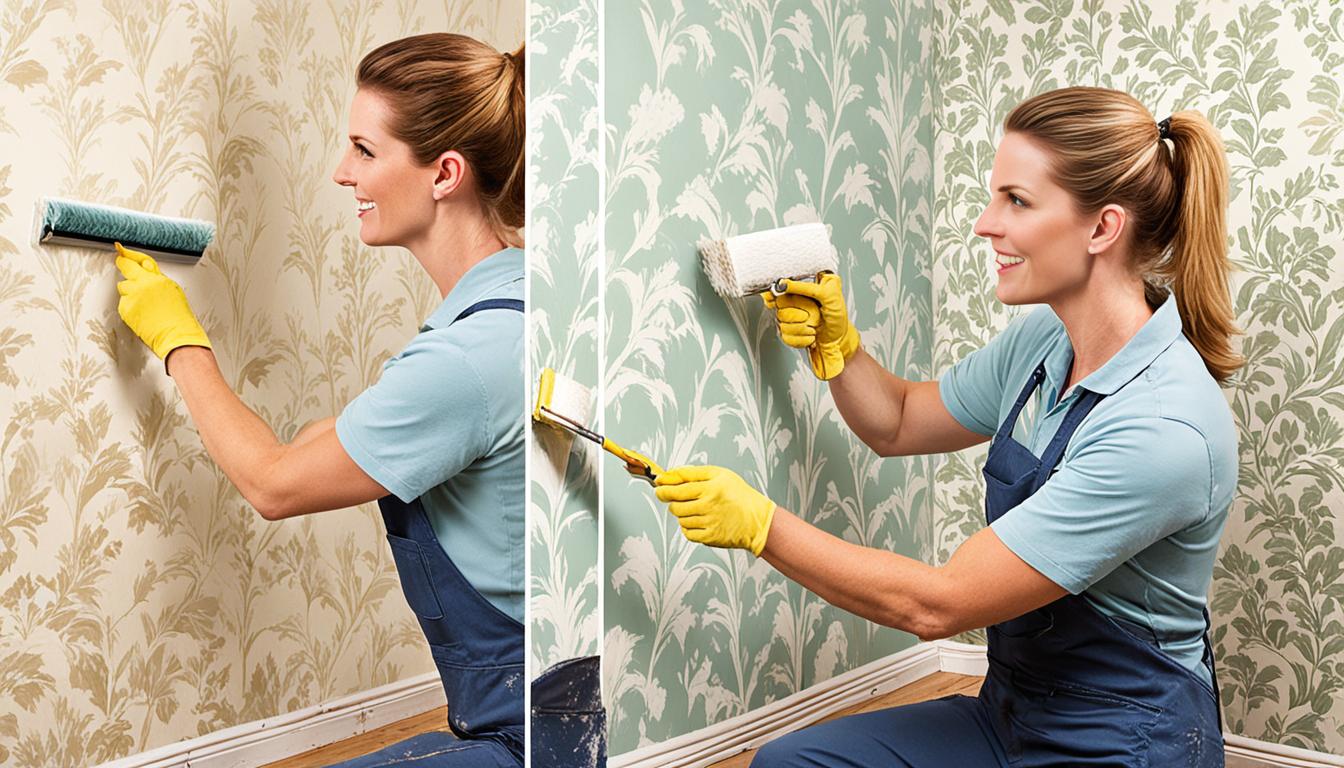I work at Pro Painters in Salt Lake City and answer lots of questions. Often, people ask if they can paint over wallpaper. Yes, you can give wallpapered rooms a new color without removing the old paper. This option is great if removing the wallpaper is too expensive or could harm the walls. To get a smooth, new look, you must prepare the surface well. But remember, if the wallpaper is textured or damaged, painting over it won’t work well. Follow my advice to make your interior painting project perfect.
Key Takeaways
- Painting over wallpaper offers a cost-effective and less damaging alternative to wallpaper removal.
- Preparation is paramount; a thorough clean and smooth surface is essential for a successful paint job.
- Opt for the right primer and paint to avoid wallpaper peeling and to achieve durable results.
- Steer clear from painting over textured or damaged wallpapers to avoid highlighting imperfections.
- With professional guidance, painting over wallpaper can lead to a refreshing and long-lasting upgrade to your interior space.
The Truth About Wallpaper and Paint Compatibility
I’ve learned a lot as a professional painter, especially about wallpaper and paint integration. Not every wallpaper is good for painting on. This is especially true for special kinds like fabric-backed vinyl, which doesn’t hold paint well. If the wallpaper is old or layered, it’s best to take it off to avoid problems. But if taking it off might harm the walls, and it’s still in good shape, then painting is an option.
Choosing the right wall covering solutions is key. Don’t use a water-based primer. It might make the wallpaper peel off because it’s moist. Instead, an oil-based primer works best. It creates a strong shield. This keeps the wallpaper in place and makes sure the paint sticks.
| Type of Wallpaper | Suitable for Painting | Recommended Primer |
|---|---|---|
| Vinyl | Yes | Oil-Based |
| Fabric-Backed Vinyl | No | N/A |
| Paper-Backed Vinyl | Yes | Oil-Based |
| Traditional Paper | Conditional | Oil-Based if Stable |
Knowing the differences between wallpaper types and their painting needs is important. With the right wall covering solutions, you can change your space. And you won’t harm the walls’ look or strength.
Evaluating Your Wallpaper’s Condition
Before painting over wallpaper, I always start with a detailed wallpaper inspection. It’s important to spot any problems that might affect the paint. This step is key in paint over wallpaper preparation.
First, look for peeling or loose wallpaper. These issues can cause bumps and flaws in your painted walls. To fix loose edges, use seam adhesive. A bit of mud applied and then sanded makes for a smooth surface ready to paint.
Careful cleaning of the wallpaper is also key. Too much water can weaken the glue holding the wallpaper. I suggest cleaning with a dry or just damp cloth to avoid too much moisture.
Here’s a simple checklist for getting your wallpaper ready:
- Start with a thorough check of the wallpaper, especially the seams and damaged areas.
- Stick back any loose parts with good seam adhesive.
- If there are visible seams or damage, apply wall mud and sand it smooth.
- Avoid using too much water when cleaning.
This careful planning and prep work will help ensure a great paint job on wallpaper. The goal is to achieve beautiful and lasting results.
Ensuring a Smooth and Lasting Finish
To get a smooth and lasting paint job, I follow a detailed process. First, I clean the walls well. It’s crucial to remove dust and dirt that can block the paint from sticking.
Painting techniques need to be spot on, especially over wallpaper. I’ve learned that an oil-based primer is essential. It seals the old wallpaper glue that might stop the paint from sticking.
Then I fix any wallpaper damage and sand down rough spots. Making the surface smooth is key to hide any flaws under the paint. After prepping, I tape off the edges to keep paint off the trim and molding.
According to Terry Koubele from Five Star Painting, using a “W” pattern when rolling on the paint helps. This avoids streaks and makes the coat even. Choosing the right paint, like low-sheen latex, is vital for a good look and lasting finish.
| Step | Description | Materials Needed |
|---|---|---|
| Cleaning | Remove all dust and dirt from the walls. | Soap, sponges, water |
| Priming | Apply an oil-based primer to seal old wallpaper glue. | Oil-based primer, rollers, brushes |
| Repair and Sand | Fix damages and sand down textured areas. | Sandpaper, putty knife, spackle |
| Taping | Protect molding and trim from paint stains. | Painter’s tape |
| Painting | Apply low-sheen latex paint using a “W” pattern. | Low-sheen latex paint, rollers |
In the end, using these painting methods ensures a beautiful and durable finish. Attention to prep work really pays off. It can make or break how well and how long your paint job lasts, especially on wallpaper.
The Crucial Step of Priming Over Wallpaper
In my years of working with walls, I’ve learned a key thing. The success of painting over wallpaper is all about priming first. It acts as a helpful middleman, making sure the new paint and wallpaper get along. I always use oil-based primers. They stop the old glue from making the new paint peel or bubble.
Before adding new color, walls need to be ready and blank. This is when the gray-tinted primer comes in. It’s crucial for bringing out the depth of dark colors. The drying time of the primer is very important. Rushing can cause stickiness or poor sticking of the paint. Always wait for the primer to dry fully. Make sure your room is well-ventilated to keep the air safe.
Taking your time on this step is investing in your walls’ future. A strong base made with good primers helps the final coat not only look great but last. This ensures your walls shine with the life and color you dreamed of.
FAQ
Can I really paint over wallpaper?
Yes, you can paint over wallpaper. It’s a good choice when taking it off might hurt your walls. Make sure the wallpaper base is ready. Use the right primer and paint for a flawless look.
Are all types of wallpaper suitable for painting over?
Not every wallpaper works well with paint. Avoid painting over fabric-backed vinyl or wallpapers that peel. If your wallpaper sticks well and isn’t the kind that repels paint, painting can work well.
How do I know if my wallpaper is in good enough condition to paint over?
Check your wallpaper carefully to see if you can paint it. Look for peeling, bubbling, or damage. If your wallpaper is stable and sticks well, it’s ready to be painted.
What painting techniques should I use to paint over wallpaper for a smooth finish?
Start by making the surface clean and smooth. Fix any flaws and sand down textures. Use an oil-based primer to protect the wallpaper. Then, choose a low-sheen latex paint.
Paint with a “W” pattern to cover well and make it last.
Why is priming necessary before painting over wallpaper?
Priming is key. It locks in the wallpaper glue, stops it from mixing with the paint, and helps the paint stick. Use an oil-based primer to get ready for any paint on top.
Can you provide tips for integrating paint with different wallpaper materials?
First, know your wallpaper type. Vinyl and textured ones need a special approach compared to thinner, paper ones. A top-quality oil-based primer helps the wallpaper not soak up paint. It makes a solid base for the paint.
What are the alternatives if wallpaper removal seems too costly?
Painting over it is a smart move. Use the right primer and paint to refresh your space without removing the old wallpaper. It’s easier and saves money.
How should I prepare my walls for painting over wallpaper?
Getting walls ready is important. Clean them, fix any damage, and stick any loose parts back. After cleaning and drying, apply primer for a smooth start for painting.




